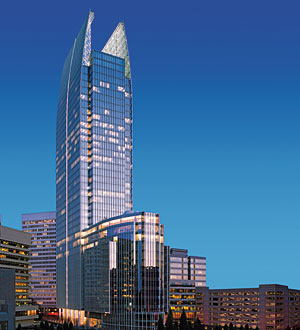Catherine Fox is the art and architecture critic of the Atlanta Journal-Constitution.
 Catherine Fox | |
“Buildings here in Atlanta remain disappointing, with a few exceptions,” states Catherine Fox, the art and architecture critic for the Atlanta Journal-Constitution. Renzo Piano’s addition to the High Museum is one of those exceptions. “The expansion, which is actually three buildings and a restaurant arrayed around a plaza, opened in 2005. As you’d expect, it’s a handsome project, designed to complement rather than outdo the Meier building, and it offers wonderful spaces for viewing art. The “piazza” at the center of the complex “is the connective tissue,” says Fox, “but I don’t think it has quite succeeded as the gathering space he envisioned. It’s rather bare, and people tend to stick to the edges, where there is seating beneath the trees.”
Another pleasant exception, says Fox, is 1180 Peachtree, a high-rise office building designed by New Haven–based Pickard Chilton. The 41-story tower, completed in 2006, is part of “a suite of buildings that are remaking midtown,” says Fox. “Midtown is really filling in and rising up. Developers seem to have gotten the New Urbanist mantra, and people are moving here from the suburbs.”

1180 Peachtree
Disappointing projects include the World of Coca-Cola museum, designed by the Jerde Partnership. “It’s a terrible building,” declares Fox. “It sits right on Centennial Olympic Park, but turns its back to the park. Instead, it faces the aquarium, which faces the other direction.”
Fox is also disappointed that plans for the Santiago Calatrava–designed symphony seem to be “dead in the water,” with fund-raising halted and the client looking for a new site. Meanwhile, developer John Wieland’s plan to build a condo project designed by David Chipperfield across the street from the High Museum also seem to be on hold.
As downtown and midtown are attracting more residential development, close-in neighborhoods like Buckhead are becoming more urban, too. Novare Group, a local developer, recently acquired a 9-acre parcel in Buckhead and plans a mixed-use project with retail, offices, and luxury condos. “The architecture isn’t great, but the project shows the ambitions of the developer,” states Fox.
The biggest story in Atlanta, says Fox, may be the construction of the BeltLine, a 22-mile transit line that will incorporate bike paths, parks, and plazas. The project will use a largely abandoned 19th-century rail line wrapping around the city’s urban core to connect 45 neighborhoods. Private developers have already started building adjacent to the BeltLine, attesting to its “potential as an engine for economic” growth, says Fox. “Rooted in the city’s railroad history, the BeltLine could become the city’s civic symbol, linking the past and present even as it shapes the future,” states Fox.
While Fox is excited about the potential of the BeltLine to transform the city and offer Atlantans a viable alternative to the automobile, she expresses concern that as yet “there is no coherent design vision” for the project. “The question now is: Will the BeltLine be more than just a transportation project?”
Looking south to Miami, where she recently visited, Fox reports that the most anticipated project is Herzog & de Meuron’s Miami Art Museum, which is scheduled to open in late 2010. In Miami Beach, she “wasn’t thoroughly impressed” by Aqua, the New Urbanist community master-planned by Duany Plater-Zyberk. “It’s certainly better than most condo developments, but the architecture isn’t really memorable, and it’s an enclave, so you need to drive to get anywhere else.”




Post a comment to this article
Report Abusive Comment